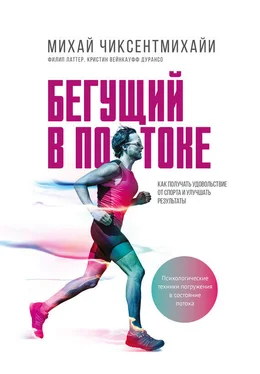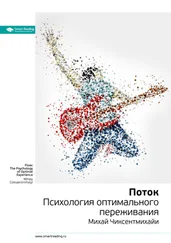Chapter 1
Allan P. Four “confusing” Zen quotes and what you can learn from them. Life Hacker. 2014. lifehacker.com/four-confusing-zen-quotes-and-what-you-can-learnfrom-1676177538.
Conley C. Peak: How great companies get their mojo from Maslow . San Francisco: Wiley, 2007.
Csikszentmihalyi M. The evolving nature of work. NAMTA Journal . 2003, 28(2), 87–107.
Csikszentmihalyi M. Flow: The psychology of optimal experience. N.Y.: HarperCollins, 1990.
Csikszentmihalyi M. Play and intrinsic rewards. Journal of Humanistic Psychology . 1975, 15(3), 41.
Csikszentmihalyi M. The flow experience and its significance for human psychology. In: M. Csikszentmihalyi, I.S. Csikszentmihalyi (Eds.), Optimal experience: Psychological studies of flow in consciousness . N.Y.: Cambridge University Press. 1988, 15–35.
Dietrich A. Neurocognitive mechanisms underlying the experience of flow. Consciousness and Cognition: An International Journal . 2004, 13(4), 746–761. doi: 10.1016/j.concog.2004.07.002.
Dietrich A., Audiffren M. The reticular-activating hypofrontality (RAH) model of acute exercise. Neuroscience and Biobehavioral Reviews . 2011, 35(6), 1305–1325. doi: 10.1016/j.neubiorev.2011.02.001.
Dunn E.W., Gilbert D.T., Wilson T.D. If money doesn’t make you happy, then you probably aren’t spending it right. Journal of Consumer Psychology . 2011, 21(2), 115–125. doi: 10.1016/j.jcps.2011.02.002.
Fetters K. How to achieve a runner’s high. Runner’s World Online. 2014. www.runnersworld.com/running-tips/how-to-achieve-a-runners-high.
Gleiser M. How runners get high. 13.7 Cosmos and Culture. 2016. www.npr.org/sections/13.7/2016/04/20/474863739/how-runners-get-high.
Gunaratana B. Buddhist concept of happiness. Bhavana Society. 2002. www.bhavanasociety.org/resource/buddhist_concept_of_happiness.
Jackson S.A., Csikszentmihalyi M. Flow in sports: The keys to optimal experiences and performances . Champaign: Human Kinetics, 1999.
Maslow A.H. Motivation and personality . N.Y.: Harper, 1954.
Maslow A.H. Cognition of being in the peak-experiences. In: Maslow A.H. Toward a psychology of being . Princeton: D. Van Nostrand. 1962, 67–96. doi: 10.1037/10793-006
Von Tevenar G. Nietzsche and ethics. Bern: Peter Lang AG, 2007.
Chapter 2
Baer R. Mindfulness training as a clinical intervention: a conceptual and empirical review. Clinical Psychology. 2003, 10(2), 125–143.
Cooley C. Human nature and the social order . N.Y.: Scribner’s Sons, 1902.
Csikszentmihalyi M. Finding flow: The psychology of engagement with everyday life . N.Y.: Basic Books, 1997.
Csikszentmihalyi M., Rathunde K.R., Whalen S., Wong M. Talented teenagers: The roots of success and failure . N.Y.: Cambridge University Press, 1993.
Dietrich A., Sparling P.B. Endurance exercise selectively impairs prefrontal-dependent cognition. Brain and Cognition . 2004, 55(3), 516–524. doi: 10.1016/j.bandc.2004.03.002.
Dietrich A., Stoll O. Effortless attention, hypofrontality, and perfectionism. In: B. Bruya (Ed.), Effortless attention: A new perspective in the cognitive science of attention and action . Cambridge: MIT Press, 2010, 159–178.
Dweck C.S. Motivational processes affecting learning. American Psychologist . 1986, 41(10), 1040–1048. doi: 10.1037/0003-066X.41.10.1040.
Emmons R.A. Abstract versus concrete goals: Personal striving level, physical illness, and psychological well-being. Journal of Personality and Social Psychology . 1992, 62(2), 292–300. doi: 10.1037/0022–3514.62.2.292.
Jackson S.A. Toward a conceptual understanding of the flow experience in elite athletes. Research Quarterly for Exercise and Sport . 1996, 67(1), 76.
Jackson S.A., Csikszentmihalyi M. Flow in sports: The keys to optimal experiences and performances . Champaign: Human Kinetics, 1999.
National Institutes of Health. Mindfulness meditation reduces pain, bypasses opioid receptors. 2016. NCCIH Research Blog: https://nccih.nih.gov/research/blog/mindfulness-meditation-pain.
Smith E.R., Mackie D.M. Social psychology. 3rd ed. Hove: Psychology Press, 2007.
Stavrou N.A., Jackson S.A., Zervas Y., Karteroliotis K. Flow experience and athletes’ performance with reference to the orthogonal model of flow. The Sport Psychologist . 2007, 21(4), 438–457.
Sugiyama T., Inomata K. Qualitative examination of flow experience among top Japanese athletes. Perceptual and Motor Skills . 2005, 100(3), 969–982.
Tang Y., Ma Y., Wang J., Fan Y., Feng S., Lu Q., … Posner M.I. Shortterm meditation training improves attention and self-regulation. Proceedings of the National Academy of Sciences of the United States of America . 2007, 104(43), 1715217156. doi: 10.1073/pnas.0707678104.
Ullen F., de Manzano O., Almeida R., Magnusson P.K.E., Pedersen N.L., Nakamura J., Csikszentmihalyi M., Madison G. Proneness for psychological flow in everyday life: Associations with personality and intelligence. Personality and Individual Differences. 2011, 52, 167–172.
Yerkes R.M., Dodson J.D. The relation of strength of stimulus to rapidity of habit-formation. Comparative Neurology and Psychology. 1908, 18, 459–482.
Chapter 3
Csikszentmihalyi M., Rathunde K.R., Whalen S., Wong M. Talented teenagers: The roots of success and failure . N.Y.: Cambridge University Press, 1993.
Csikszentmihalyi M. Finding flow: The psychology of engagement with everyday life . N.Y.: Basic Books, 1997.
Dietrich A., Sparling P.B. Endurance exercise selectively impairs prefrontal-dependent cognition. Brain and Cognition . 2004, 55(3), 516–524. doi: 10.1016/j.bandc.2004.03.002.
Dietrich A., Stoll O. Effortless attention, hypofrontality, and perfectionism. In: B. Bruya (Ed.), Effortless attention: A new perspective in the cognitive science of attention and action. Cambridge: MIT Press, 2010, 159–178.
Dweck C. S. Motivational processes affecting learning. American Psychologist . 1986, 41(10), 1040–1048. doi: 10.1037/0003-066X.41.10.1040.
Elliot A.J., Gable S.L., Mapes R.R. Approach and avoidance motivation in the social domain. Personality and Social Psychology Bulletin. 2006, 32, 378–391.
Goldberg L.R. An “Alternative description of personality”: The big-five factor structure. Journal of Personality and Social Psychology. 1990, 59(6), 1216–1229.
Hanson R. Hardwiring happiness: The new brain science of contentment, calm, and confidence . N.Y.: Crown Publishing, 2013.
Hudson N.W., Fraley R.C. Volitional Personality Trait Change: Can People Choose to Change Their Personality Traits? Journal of Personality and Social Psychology. 2015, 109(3), 490–507. http://dx.doi.org/10.1037/pspp0000021.
Jackson S.A., Roberts G.C. Positive performance states of athletes: Toward a conceptual understanding of peak performance. The Sport Psychologist . 1992, 6(2), 156–171.
McCrae R.R., Costa P.T.J. Personality in adulthood . N.Y.: Guilford, 1990.
Smith E.R., Mackie D.M. Social psychology. 3rd ed. Hove: Psychology Press, 2007.
Strachman A., Gable S.L. What you want (and do not want) affects what you see (and do not see): Avoidance social goals and social events. Personality and Social Psychology Bulletin. 2006, 32, 1446–1458.
Ull е n F., de Manzano O., Almeida R., Magnusson P.K.E., Pedersen N.L., Nakamura J., Csikszentmihalyi M., Madison G. Proneness for psychological flow in everyday life: Associations with personality and intelligence. Personality and Individual Differences. 2011, 52, 167–172.
Читать дальше
Конец ознакомительного отрывка
Купить книгу







![Данила Кузнецов - Язык кино. Как понимать кино и получать удовольствие от просмотра [litres]](/books/415652/danila-kuznecov-yazyk-kino-kak-ponimat-kino-i-pol-thumb.webp)




